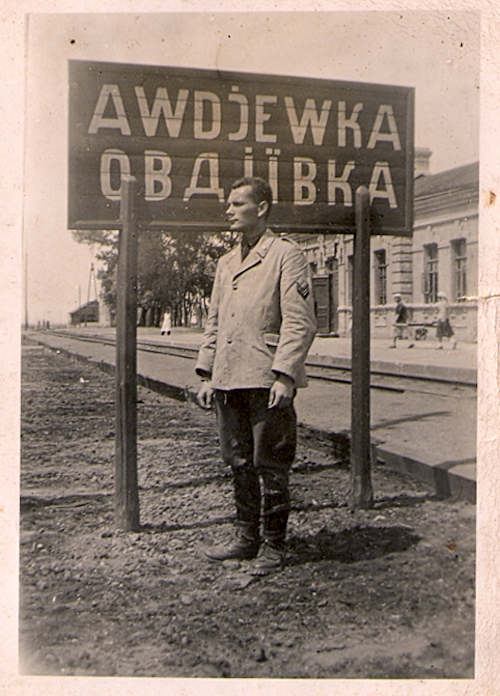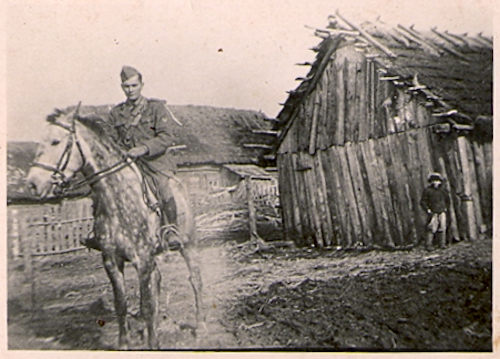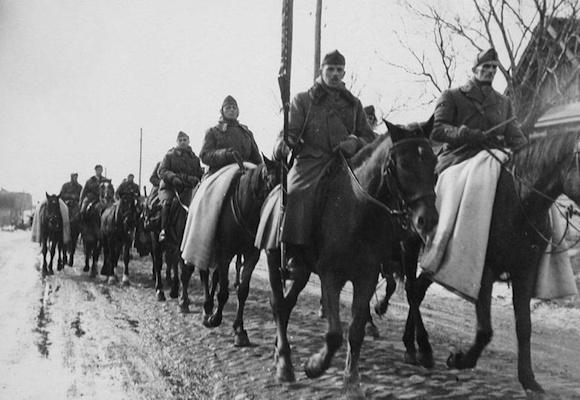In memory of my father Angelo, who died in 2009 just before my nephew was born, and to all the men of the Savoy Cavalry.
Beginning in the spring of 1941, the Savoy Cavalry it was used for the occupation of Croatia and, in the summer of the same year, it was assigned to the Russian front, as part of the 3rd division Celere Prince Amedeo Duca d'Aosta, del Italian expeditionary force in Russia (CSIR).
Il Savoy departed from Italy on July 22 1941 on the railway, divided into sections, on days 24 and 25, it passed the Brenner. He crossed Austria and reached Hungary at the Borsa station 80 kilometers from the Romanian border. He then reached Frasin where he left the train and continued by truck for 150 kilometers to Botosani in Romania. From this location the regiment continued on horseback. The path to the front was undertaken in successive stages through the Carpathians along the roads of Moldavia, Bessarabia and Ukraine, following the Trusesti-Nikoreny route, arriving on 10 August in Soroki where the regiment stopped for a day.
Ukraine welcomed them with its wide landscapes, fields of wheat, rye, oats, sunflowers, accompanied by a great heat. For kilometers and kilometers, there are woods to woods, fields to fields, scattered the dark spots of the houses, without a bell tower, a tower that delineates their existence. There are also few strips of roads, while those of earth or mud are visible, due to the alignment as military, of the wooden poles of the telegraph, and of the light that run alongside them. An ancient landscape, glimpses of medieval life that appear and disappear in the immensity of the plain. Squads of Russian prisoners intent on work silent witnesses of a passage of all kinds of vehicles, moved by a frenetic race towards the east. On the sides of the road, the signs of the war that has just passed, remains of tanks from which a red star appears, cannons, smashed and already rusty cars, evident remains of the lightning clashes that the Germans had had in their fast race to the east.
August 29th, the Savoy continued to Ositeski, Novo Alexandrovka, Novo Ukrainka, Adzamka.
In the early September the regiment reached the Dnieper River, while the Germans were preparing the campaign on Kiev and the Sea of Azov.
Il September 5th the whole regiment is in Jodssjolk Oulj. From the following day until the 25th he remained deployed on the right bank of the Dnieper.
September 26th, Torino, Celere and the Tagliamento Blackshirts begin the advance from the Dnepropetrowsk bridgehead. Four days later, the entire Italian expeditionary force passed under the control of von Kleist's army. On the same days the Savoy he was engaged for the first time in the surroundings of Dnepropetwosk, strenuously defended by the Russians.
Thus began the task that he would have carried out with courage and self-denial: the patrol and control of a vast territory between Auly and Romanocovo.
In the night between 1 and October 2, the regiment crossed the Dnjepr river on a bridge thrown by the Engineers.
18 October, the division began the movement to the city of Stalino (now Donetsk) on Savoy marched in the lead, preceding the bulk of about 30 kilometers. The march soon became tiring due to the mud and cold.
1th November il Savoy arrives in Korssunj and stayed there until the 3rd, the next day he went to Sofyeva, remaining for five days deployed on foot, then a department of the Pasubio he replaced the regiment which returned to Korssunj. After a few days he went to Gorlovka.
5th November the Italian contingent occupies Nikitovka, the Soviet counterattack lasts six days and forces the Italians to retreat with hundreds of dead and wounded.
6th November, the first snow has fallen, the cold burns the face and the hands stick to the metal, the breath condenses, and the sun illuminates and makes the snow sparkle, but it does not heat. With the advance of winter, life seems more and more unreal, the days are very short also due to the fact of the alignment of the time with Berlin and already from the early afternoon shortly after three it gets dark. Men are without ear muffs, balaclavas, padded jackets, or padded gloves. The number of men suffering from frostbite multiplied exponentially. Horses also suffer from cold and hunger. The oats do not arrive, the frozen straw on the roofs of the huts does not appease the hunger, but on the other hand it makes them sick with glanders, (contagious infectious disease that affects horses and donkeys, damaging their mucous membranes, skin and internal organs ); colic thrives, and horses die. The horses could not stand this terrible climate with the same stamina as the Russian ones.
In the following days of November the command of the CSIR ordered that a squadron of the Savoy acted in his employ, and for about a month, more or less between mid-November and the end of December, he worked on the entire front of the division, the Russians defined him: The ghost squadron. He was tasked with patrolling the gap between the Celere and some German departments and to maintain contact with each other.
 27th November the regiment was ordered to withdraw and go to Awdiewka for the reorganization of the units and for a rest period. The month of December was particularly rigid and the regiment was blocked by the cold, while supplies were becoming more scarce.
27th November the regiment was ordered to withdraw and go to Awdiewka for the reorganization of the units and for a rest period. The month of December was particularly rigid and the regiment was blocked by the cold, while supplies were becoming more scarce.
25th December, on Christmas day, the Russians unleashed their offensive against the Italian positions, they attacked Nowaja Orlowa preceded as always by a very violent artillery fire. The greatest impact was sustained by the Bersaglieri of the 3rd regiment and the Black Shirts of the Tagliamento. At nine in the morning, the whole area was a circle of hell, the Russians were advancing pressing against the center of the country. It was the 296th Russian Infantry Division. Towards evening the country was already in the hands of the Soviet troops. Fortunately, formations of German tanks gravitated in the vicinity, which intervened, the next day the Russians abandoned Nowaja Orlowka. The Russians before retreating systematically destroyed the doors and windows of all the houses, which they could not completely tear down. So even those few left standing are unusable and constitute an insignificant shelter against the cold.
Santo Stefano, the thermometer shows 46 degrees below zero and blows a wind so strong that it is impossible to walk on the streets reduced to a sheet of ice.
30th December, the battle of Christmas ends, the Italian losses are 168 dead, 715 wounded, 305 frozen and 207 missing. The Russians proposed with this battle, to break through the lines held by the CSIR, and get to Michailowka and from there aim at the city of Stalino, if this goal were achieved, it would have put a front of over 100 kilometers in crisis, that is to say the entire German array to the sea, which would have been threatened with encirclement.
21 March, first day of spring, with thirty degrees below zero and half a meter of snow. At the end of March it was still snowing profusely, and at night the spring storms raged that hit swamps and woods, and freeze anyone who hasn't found a hole in the ground, or an improvised shelter.
In April the weather conditions changed definitively, the temperature drops to zero degrees, the snow and ice melt. In order to integrate the decimated ranks of the CSIR, the Ustascià of Pavelich also arrive. It is a Croatian unit trained in Italy that will fight for a few months with the Italians, and then pass directly under the Germans. Almost all of them will die in the Stalingrad pocket.
In spring of the 1942 the grouping of troops on horseback was formed, including the regiments: Savoy, Novara Lancers e Horse Artillery. Constituting a large unit entirely mounted on horseback. It was used in patrolling and in the control of the territory to clean up the front, with exploration tasks and, above all, in the control of the rear to plug the leaks that continually opened up in the too large Italian-German deployment. The Cossack Squadrons Group, Better known as Maggiore Campello Group, placed under the Information Office of the 8th Army (ARMIR), made up of about three hundred Cossacks, highly skilled knights and convinced anti-Communists. The cadres of the unit consisted of officers and non-commissioned officers who were recognized with the rank held in the Red Army. New divisions arrived from Italy to set up ARMIR together with veterans, which was entrusted with the task of advancing in the area of the great loop of the Don, and of settling on the banks of the river near Serafimovic. The staff included, in addition to the groups already present on Soviet soil and framed in the XXXV ° Army Corps (CSIR), the divisions Sforzesca, Ravenna, Cosseria and grouping black shirts 23 March with groups Lioness e Scrivia Valley, framed in the 2nd Army Corps, and the divisions Julia, Cuneo e Tridentine, constituting the Alpine army corps. Division would later add to these forces Vicenza, formed by only two infantry regiments, with garrison duties in the occupied territories, and by the army services, for a total of 220.000 soldiers and 7.000 officers.
Fierce fighting was sustained from 30 July to 13 August by the Celere for the conquest of the small bridgehead on Serafimovic's Don.
August 24th the famous happened charge of Izbusensky (sometimes also referred to as "Isbuschenskij"), located in the district of Serafimovicskij near a bend in the river Don. 650 knights faced about 2.000 Soviets. The losses, for the regiment, amounted to 32 dead, 52 wounded and over 100 horses out of action. For the Russians, however, the losses were 150 dead, 300 wounded and 500 prisoners. They also left in the field 4 cannons, 10 mortars, 50 machine guns and hundreds of rifles. This day earned the regiment 54 silver medals, the gold medal for Major Litta, Captain Abba and the standard. The chaplain Don Lidio Passeri wrote down the names of the fallen, next to each name he drew a small cross, he will have to send the painful message to the families. The bodies of the 32 fallen were lovingly composed by fellow soldiers, and buried in a small cemetery near Bolschoi. Each fallen one was accompanied to the extreme abode by a volley from the honor guard and by the prayers of Don Lidio Passeri.
September 13th, the change takes place with the Alpine troops, and the Savoy retires in the second row to Duboskoj and then to Papoff.
6 October a Film Luce troupe arrives at the Savoy camp and for a whole day films the regiment in repeated positions for future screening in Italy. Of the real charge there are only a few blurry shots, taken by Captain Abba, before falling killed.
 19-20-21 December, the Soviets complete the attack. The Italian retreat begins with two columns, the first formed by the divisions Ravenna, Pasubio, and Torino; the second from rates of the Pasubio, From Celere, and from the Sforzesca.
19-20-21 December, the Soviets complete the attack. The Italian retreat begins with two columns, the first formed by the divisions Ravenna, Pasubio, and Torino; the second from rates of the Pasubio, From Celere, and from the Sforzesca.
24th December, the first Italian column, closed in the Arbusovka pocket, breaks the encirclement, but parts of the Pasubio and Turin remain encircled at Certcovo.
On the night of 28th December, the second Italian column also reaches the German lines at Skassisrkaia. The Alpine Army Corps composed of the divisions: Cuneo, Julia e Tridentine they are still deployed on the Don front.
End of December, a part of knights has been on foot and destined to fight with infantrymen and Alpine soldiers in Rossosk, very few will come back.
16st January in the night with 35 ° below zero the column leaves with the horses white with frost and the soldiers on foot to avoid easy freezing. The walk in the snow is over 1.000 km. The new German lines are reached on 4 February. A hospital train leaves for Italy with injured and sick people. The others continue the march on horseback and reach Kharkov and then Gomel.
19st January, eighty minutes of concentrated artillery sounds the beginning of the Russian attack, then the first Russian waves advance in the thick fog. It is the end and the beginning of what history will remember as Russia's tragic retreat. Soviet tanks had arrived in Valujki on Oskol 120 kilometers from the starting point. The German device leaves the Caucasus. The Alpine Army Corps is also practically surrounded. At 10.00 he receives the order from General Gariboldi to fall back. Another tragedy begins. The Russians launched 21 infantry divisions, 11 cavalry and 10 armored brigades, about 650 tanks, against seven German divisions, targeting the Dnepropetrovsk-Stalino railway, through which all the reinforcements of the 17th army passed.
26st January, at 12.00 the battle of Nikolajewka begins, it will be a date that many soldiers and many families will never forget. In Nikolajevka (it no longer exists, having been absorbed by the city of Livenka), several platoons and entire companies went to their deaths. The Russian wagons had passed the Don, had waited for the thickness of the ice on the river to be more than one meter, covered by another meter of snow, at which point they had launched their T34 wagons which swept across the snowy steppe. Behind them, as always, thousands of infantrymen from Siberia and the Caucasian republics, men with typical Asian features and like their ancestors, strong and cruel. The captured soldiers were unarmed and set off in long lines to the east, and the columns thinned more and more, every hour, every night. The path was marked by a line of corpses that the fresh snow mercifully covered. Here history presented its account, the retreat was an unspeakable drama that cost tens and tens of thousands dead, and the total destruction of our entire army in the land of Russia, thousands of trucks, cannons, quadrupeds, and all the warehouses disappeared in the snow of the steppe.
9 March 1943, the march had not stopped, the thermometer indicated between 27 and 10 degrees below zero, after 17 days the Savoy Cavalry arrives in Gomel. The regiment still has the strength to enter Gomel in perfect trim, and parade, banner in the wind, to the incredulous admiration of the German garrison. 50 interminable days have passed since the departure from Nikitowka, and 1.068 km have been covered, with only 13 days of rest. Spirit and discipline have ensured that the losses in men have been minimal, always by freezing.
26 March 1943 il Savoy he returns to Italy, a translation awaits them, a short march towards the railway station, or rather towards its ruins, under a heavy sleet. From Belarus they went down to Ukraine, down to Winniza then, crossing the Carpathians, they entered the Hungarian puzsta again.
2 April 1943 the regiment arrived in Italy, at the Osoppo station, where it attended to all the operations planned for the troops returning from the front, all the personnel remained for fifteen days in a contumacial camp, relegated to a large barracks outside the city; free exit was forbidden, and they could not have any contact with civilians.
April, ARMIR also repatriates divisions Ravenna e Cosseria, will arrive in Italy in the following month. Thus ends, with a tremendous disaster of men and means, the adventure desired by Mussolini in the land of Russia.
REFERENCES
Bibliography Riccardo Balzarotti - Alessandro Bettoni Cazzago
Mario Veronesi - My Russia (diary of a war)
Maurizio Brignoli - The history of the Savoia Cavalleria
Photo: author












